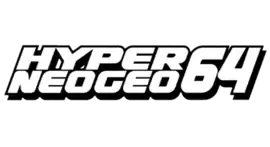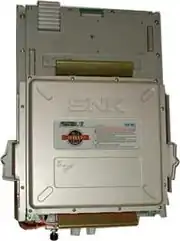Hyper Neo Geo 64
The Hyper Neo Geo 64 is an arcade system created by SNK, and released in September 1997, as the successor of the Neo Geo MVS, within the Neo Geo family.
 | |
 Hyper Neo Geo 64 (System board and Software) | |
| Manufacturer | SNK Corporation |
|---|---|
| Product family | Neo Geo |
| Type | Arcade system board |
| Release date |
|
| Media | ROM cartridge |
| Storage | Memory card |
| Predecessor | Neo Geo MVS |
It is the first and only SNK hardware set capable of rendering in 3D, and was meant to replace SNK's older MVS system on the market. Company executives planned for the project to bring SNK into the new era of 3D gaming that had arisen during the mid-1990s, and had planned for a corresponding home system to replace the aging and expensive AES home console.
However it never managed to match the huge success of the MVS, and reached its end of life in 1999. Only seven games were produced for the arcade variation of the system, none of which proved particularly popular, and the project was discontinued. The proposed home system never got beyond initial planning stages and only one of the arcade games, Fatal Fury: Wild Ambition, has been ported to home systems.
History
The Hyper Neo Geo 64 was conceived to bring SNK into the 3D era as well as to replace their aging Neo Geo home system.
The system was first announced in late 1995, and planned for release in late 1996.[1] It was officially unveiled at the February 1997 AOU show, though all that was demonstrated at the show was a videotape containing a few seconds of footage of Samurai Shodown 64, which SNK announced would be the first game for the system.[2] By mid-1997 test units were on display in Japan.[3]
The arcade version of the system was released in September 1997, featuring a custom 64-bit RISC processor, 4 megabytes of program memory, 64 megabytes of 3D and texture memory, and 128 megabytes of memory for 2D characters and backgrounds. The first title released for the system was Road's Edge, with Samurai Shodown 64 and Fatal Fury: Wild Ambition following soon after. None were particularly well received.
By 1999, the system was discontinued, with only seven games released in total. Fatal Fury: Wild Ambition was ported to the Sony PlayStation home system.
Home system
Although details regarding the planned home system are sparse, it is believed that like the AES console, much of the hardware from the Neo Geo 64 arcade platform would also have been present in the home system, meaning gameplay would be identical or nearly identical whether a given game was played at home or in the arcade. It is unknown what media the home system would have used.
Specifications
- Processors:
- Memory layout:
- Sound chip: 32-channel PCM sample-based synthesis audio, with maximum sampling frequency of 44.1 kHz (CD-quality) and 32 MB of sample RAM
- Display:
- Color palette: 16.7 million[4]
- Maximum onscreen color palette: 4,096
- 3D branch: 96 MB vertex memory, 16 MB maximum texture memory[4]
- 2D sprite branch: 60 frames per second animation, 128 MB character memory[4]
- 2D scrolling branch: Up to 4 game planes, 64 MB character memory[4]
- Main functions: scaling, revolution, morphing; horizontal/vertical screen partitioning and line scrolling
List of games
Seven games were released, all developed and published by SNK.
| Title | Genre | Release date |
|---|---|---|
| Beast Busters: Second Nightmare | Rail Shooter | September 11, 1998 |
| Buriki One | Fighting | May 21, 1999 |
| Fatal Fury: Wild Ambition | Fighting | January 28, 1999 |
| Road's Edge | Racing | September 10, 1997 |
| Samurai Shodown 64 | Fighting | December 19, 1997 |
| Samurai Shodown 64: Warriors Rage | Fighting | October 16, 1998 |
| Xtreme Rally | Racing | May 13, 1998 |
See also
References
- Webb, Marcus (December 1995). "Arcadia". Next Generation. No. 12. Imagine Media. p. 28.
- "AOU" (PDF). Electronic Gaming Monthly. No. 93. Ziff Davis. April 1997. p. 79.
- "In the Studio". Next Generation. No. 33. Imagine Media. September 1997. p. 24.
- "Hyper Neo Geo 64". Next Generation. No. 34. Imagine Media. October 1997. p. 21.
- Webb, Marcus (November 18, 1997). "Arcadia: SNK to combine system and dedicated games" (PDF). Next Generation. No. 36 (December 1997). p. 33.